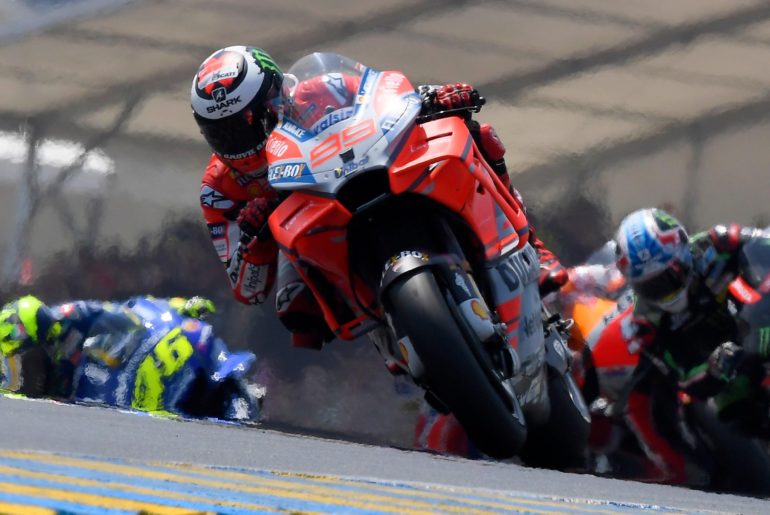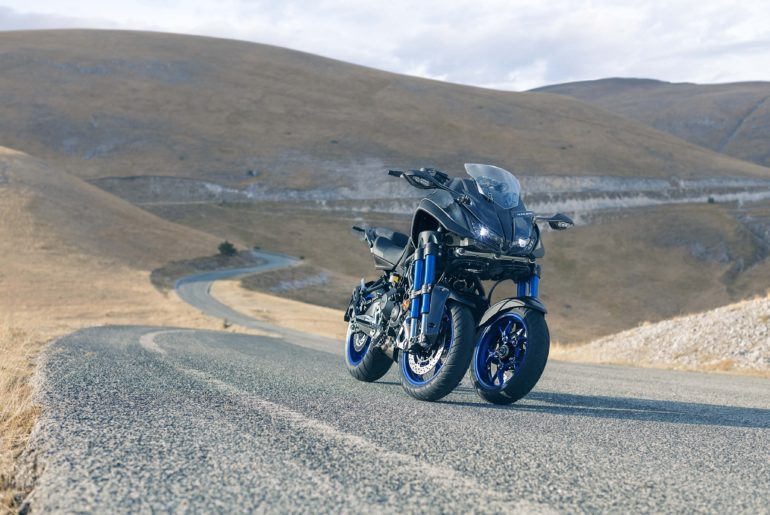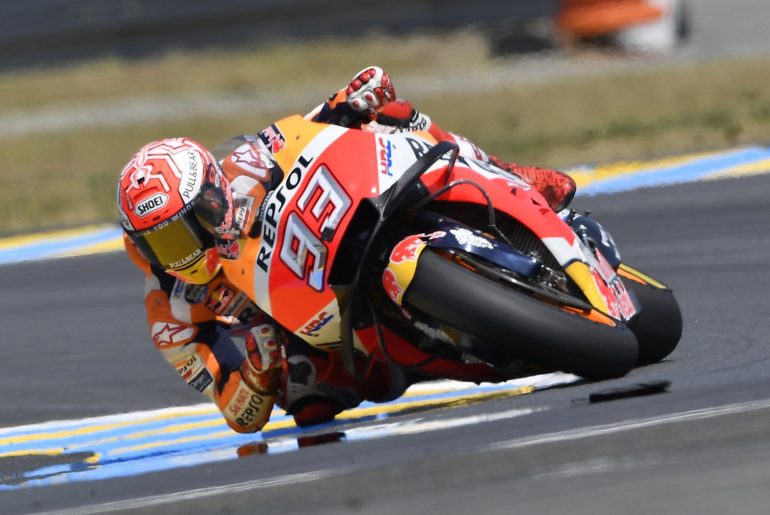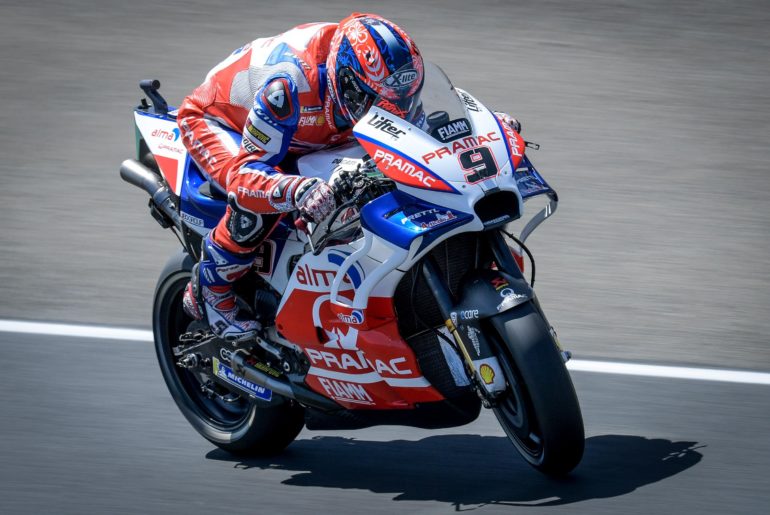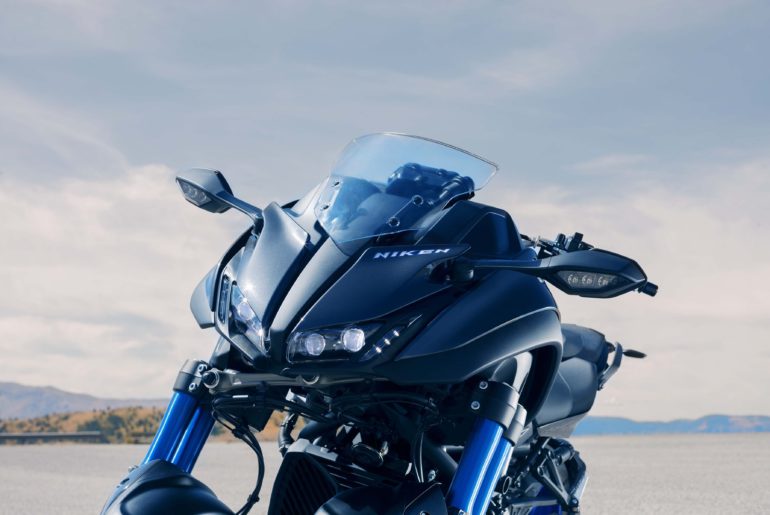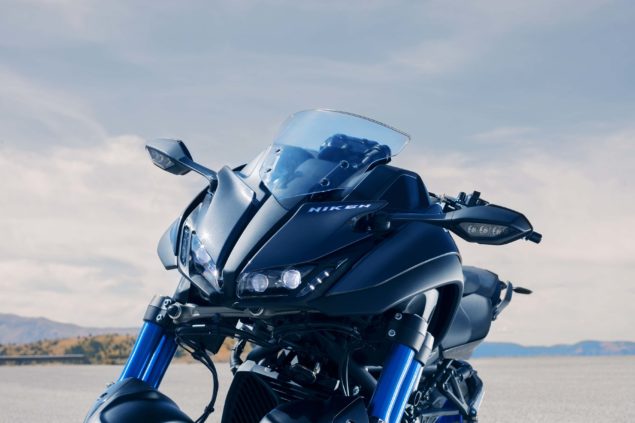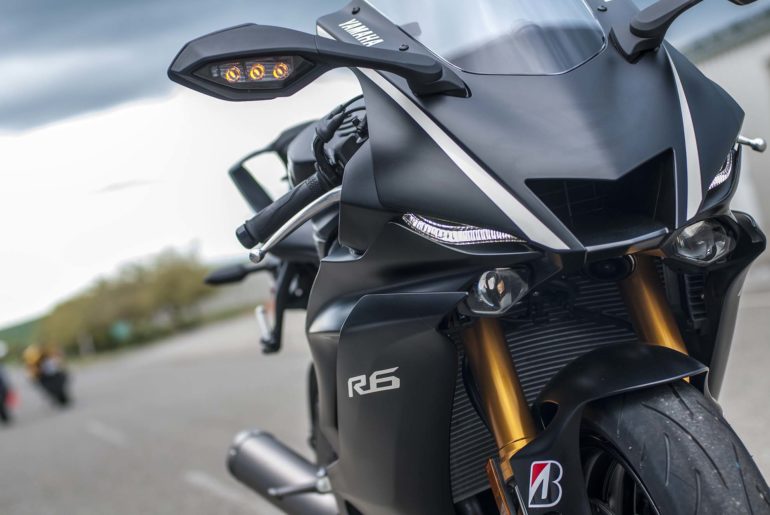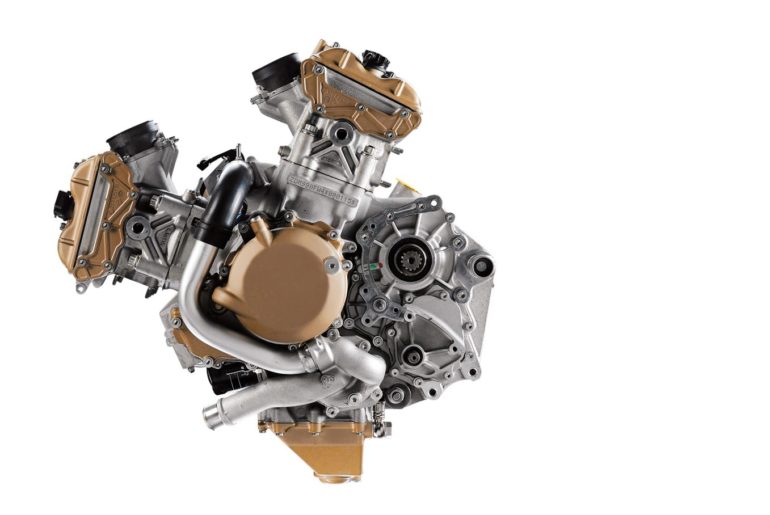Looking back, it is always easy to identify the pivotal moments in a championship. Last year, it was the Barcelona test, when Honda brought a new chassis which gave Marc Márquez the confidence he had been lacking.
In 2015, it was arguably Motegi, where Valentino Rossi stayed ahead of Jorge Lorenzo, but the effort it took in the difficult conditions left him drained at the start of a long and exhausting set of flyaways.
In 2012 it was Misano, where a tire warmer got stuck to Dani Pedrosa’s brake disc, forcing him to start from the back of the grid, and leaving him in a position to get tangled up with Hector Barbera, and crash out of the race.
In the midst of a racing season, however, such pivotal points are much harder to identify. Or rather, all too easy to misidentify. After Estoril 2006, everyone thought that Nicky Hayden’s championship challenge was over.
Valentino Rossi’s heartbreaking engine blow up at Mugello looked like it would put paid to his shot at the 2016 title, but he still kept the fight alive for a long time.
Anything can happen during the course of a season, so when we look back at a season we can easily overlook the drama of a single race that seemed important at the time. 2015 is a case in point: there were so many twists and turns that it is hard to pinpoint a single turning point, so fans and followers tend to pick their own.
Looking at it now, just five races into a nineteen-race season, it is easy to believe that the races at Jerez and Le Mans will be the turning points we look back at when the bikes are packed up for the final time after Valencia.
The three-rider crash at Dry Sack two weeks ago, in which Andrea Dovizioso, Jorge Lorenzo, and Dani Pedrosa managed to all take each other out without any obvious culprit being to blame, had a huge impact on the championship.
And Sunday’s drama-packed race at Le Mans will surely be spoken of in the same terms. Not just because of who didn’t finish the race. But also because where some riders finished is going to have a profound impact on their futures.
Tempus Fugit
Jorge Lorenzo knows that his future depends on his performance, and he went to work to secure his future from the moment the lights went out.
Lorenzo may not have mastered the Ducati Desmosedici, but he has mastered the start, and he was off the line like a rocket, shooting from sixth into the lead through Turn 1 and entering the Dunlop Chicane ahead of a chasing pack.
A couple of quick laps proved that Lorenzo could be fast, but not fast enough to shake the chasing group.
Behind him, Lorenzo had assembled quite an entourage, with Johann Zarco pushing Marc Márquez and Andrea Dovizioso wide into the chicane to take second.
It was not a move which endeared the Frenchman to Dovizioso, and caused the Italian to decide to get past the Monster Tech3 Yamaha as quickly as possible.
“My strategy was to go away from Zarco,” Dovizioso said, “because Zarco already did in Turn 2 something close to the limit, and I lose three positions.”
Dovizioso did not ascribe malice to Zarco’s moves, however. “I don’t think he’s doing it intentionally. I think it’s his way to approach the battle.”
“Also this moment [the crash involving Tom Luthi] in the warm up. I just have to make the strategy against other riders. That’s why I just decide to get one rider in between us immediately, and after think about strategy.”
First Fallers
With Zarco dealt with, Dovizioso set his sights on his teammate. Jorge Lorenzo may not be as quick as Dovizioso on the Ducati, but he can lead, and he is almost impossible to pass once he is ahead. Lorenzo turned out to be the hurdle over which Dovizioso would stumble.
The Italian put a clinical pass on Lorenzo going into the chicane, and got drive out as he headed down towards La Chapelle. But the pass left him a little bit off line, and that led him to brake a little later, causing him to lose the front and crash out of the race.
Dovizioso did not seek to place the blame anywhere other than himself. “I brake a little bit late. I was a little bit wide, so that I tried to make a slide on the rear and move the weight on the front a little bit. But the movement, I did two movements and came back.”
“When I came back, all the weight went to the front. That’s why. In that point, I didn’t take care enough to lose the front, because it happened in the practice and I didn’t expect that. The reason is in the race there is always less grip than the practice, always.”
The lower grip had already proved a problem for Andrea Iannone, who crashed the Suzuki GSX-RR on the first lap, despite starting from a strong position.
Though the race took place in near perfect weather – bright sun shone down on a packed house – the hot sun had heated the asphalt and made the surface a little greasier than it had been in the morning.
Then there was the Dunlop rubber laid down in the first two races. Had the Moto2 rubber made the track more slippery? “Next question,” Dovizioso joked.
“Nobody knows. Every time is the same story.” But it hadn’t necessarily played a role in his crash, the Ducati rider said.
“I still didn’t push until that point, because I was so comfortable. I had a really good speed. I didn’t put the front really on the limit until that moment. So I didn’t realize there was less grip than the practice. I didn’t care too much in that point. That’s why this happened.”
Heartbreak at Home
Lorenzo’s brilliant blocking would claim another victim a couple of laps later. To the immense disappointment of the packed crowd, Johann Zarco crashed out of second at Garage Vert. Lorenzo’s blocking tactics had forced the Frenchman to push beyond the safe limit in an attempt to find a way past, and he had been punished for it.
“The problem was all these laps at the beginning and trying to overtake Lorenzo was too difficult,” Zarco reflected after the race. “I tried to do it but I was losing a lot in acceleration, and then to catch him back and then to think about how to overtake him I think this took all my energy and I was more than 100%.”
Zarco laid the blame squarely on himself, though he did not feel he had a lot of choice. The dilemma he faced was to try to force a way past and risk crashing, or wait and risk being caught and passed himself.
“I did not expect to crash and I should have maybe waited to have less fuel and feel more comfortable, and for Jorge to slow to overtake him,” Zarco said.
“But the way he was pushing at the moment did not give me this possibility. If I had tried to wait even more I’m losing more positions. I’m in front of a wall and when you don’t know what to do you have to give your best.”
His decision had perhaps been influenced by the fact that it was his home race, and he was in no mood to settle for fifth. “When we started the race today it was necessary to accept that I have that machine to fight for victory, and the others have other machines with their strong and weak points,” Zarco said.
“Maybe I must race and accept to finish fifth, but I don’t think it was the mood of the weekend and the mood of the day. I don’t think the crash was about pressure it was the reality to give the best to dream about victory. I’ll keep it in mind because it will help me to grow.”
Zarco refuted the idea that the pressure of his home race had got to him, but it is hard to see how it could have been otherwise. The crowds behind Zarco’s race trucks and at the Monster Tech3 Yamaha hospitality rivaled those massed around Yamaha waiting for Valentino Rossi.
The support Zarco received was truly remarkable, beyond the level at other races for their home riders. In France, Johann Zarco is clearly a phenomenon. A race win is on the cards sometime soon, but perhaps the cauldron of Le Mans placed a little too much pressure on his shoulders.
This was, after all, only his second race crash in two seasons in MotoGP, the last coming at Qatar.
Living at the Limit
But it had been a learning experience. Zarco had soaked up the pressure and tried to turn it into positive energy. He had seen the way that Marc Márquez managed races, and understood that while it is possible to push the limit sometimes, the key to success was balancing risk with reward throughout the race.
“We can see that Marc is controlling more races, but even when he is in control he can crash, and he saved a nice one today. It means a rider can still be better. Living at that limit I will understand it.”
With Dovizioso and Zarco crashing out of the race, the championship took on a different complexion. Marc Márquez had gone from having a modest lead to seeing the potential to open a huge gap over his rivals.
With only Jorge Lorenzo ahead of him, second place would have been enough, but Márquez had his eyes on more. The Repsol Honda rider had chosen the hard rear tire, and taken a few laps to get it up to the perfect working temperature, especially given the melee at the start of the race.
“I was the only rider with the hard rear, but this morning I feel really good and I think it was the key for the race,” Márquez told the press conference. “I was able to keep a constant pace and I was so constant. Then we start the race and I knew that in the first two laps I will struggle because it takes time to get the correct temperature.”
Zarco’s tough pass on Márquez on the first lap and the chaos of those opening laps had caused him to reassess his approach. “Everything became more difficult when Johann overtook me in the third corner,” Márquez said. “I was wide and then Iannone overtook me, then he crashed in turn 5. Then I nearly hit him.”
“Two riders overtook me. Then I said, okay, cool down a little bit. Then I was pushing hard. I was trying to take the correct temperature on the tires, but then immediately I saw that – I was looking where Dovi was, because he had the best pace during all weekend.”
“When he crashed, then my approach of the race changed a little bit. Then I was more calm. I take more time because I saw that the front tire was so critical.”
Super Saver
So critical, indeed, that he nearly managed to crash out of the race once again, folding the front in the chicane before saving it. It was nearly identical to the crash he had during FP3, but fortunately for Márquez, the result was different.
“In turn 3 I had a moment like FP3,” Márquez said. “I crashed there. This crash helps me to save on the race. When I crashed in turn 3, since that moment during all the race I was always careful there. I was so stiff. My elbow was like a stick there and when I lose the front just put the elbow and I pick up the bike.”
With his tires up to temperature, Márquez could launch his attack on Jorge Lorenzo. By that point, lap 10, Lorenzo’s resistance was starting to crumble.
The Spaniard had been holding other riders off by braking late, parking the bike in the middle of the corner, then using the acceleration of the Ducati to fire it out of the corner.
This forces anyone behind to stop their bikes too, but they can never match the acceleration of Lorenzo, firstly because of the fearsome drive and mechanical grip which the Desmosedici has, and secondly be Lorenzo is getting a head start.
Lorenzo’s tactics have a weakness, however. Because of the way he is approaching the corner – more of a V shape, running deep and turning, then firing it out again – he will sometimes leave the merest hint of daylight on the inside, and that was enough for Marc Márquez to squeeze his Honda RC213V into.
With Márquez on the inside line, Lorenzo was forced to stand the bike up, losing his drive.
Once Márquez came through, a whole procession followed. Danilo Petrucci followed a couple of laps later, and Valentino Rossi shortly after that. Then came Jack Miller on the second Pramac Ducati, and eventually even Dani Pedrosa made his way through. Lorenzo ended the race in sixth, and as third Ducati.
Tanking
He put his problems down to the difficulty of holding himself up under braking. The shape of the fuel tank, which is slightly revised for this year (and which isn’t necessarily the actual container holding fuel) does not fit Lorenzo as well, and so he cannot support himself using the tank, he has to rely entirely on his arms.
That was taking all his energy, he said. “Physically I didn’t have a good support with the full tank to keep my stamina up for all the race. I am suffering with this from the beginning at tracks like Austin and here where there is a lot of hard braking.”
“Every lap it is a little bit more difficult to keep the corner speed so you need to slow down to turn the bike and they were getting closer before finally overtaking me.”
Lorenzo is hoping to test solutions at the Barcelona tire test on Tuesday and Wednesday, where the teams are gathering to check the asphalt of the newly resurfaced track. Whether Ducati can fix his problems or not, he will have to start producing better results than sixth.
There is a growing feeling of impatience with Lorenzo within Ducati, and a sense that they are disinclined to continue with him. He was paid a lot of money to come to Ducati and win a championship, but he is yet to win a race.
Other options are also disappearing, as Suzuki appears to be inclining towards signing Joan Mir, rather than Lorenzo or Andrea Iannone. A decision on Suzuki’s second rider is expected at Mugello. If they choose someone else, Lorenzo could find himself without a ride for 2019.
Run and Done
The result of the race had been pretty much decided once Jorge Lorenzo started dropping through the field. Once past the Ducati, Marc Márquez was unleashed, running a pace that was virtually impossible to match.
Virtually, but not completely, as Danilo Petrucci made a strong push to close the gap the Repsol Honda rider. Petrucci closed the gap to Márquez, helped in part by Márquez losing the front and then saving it at Turn 3.
But once Márquez gathered himself up again, he soon put clear air between himself and the Pramac Ducati rider.
“I was pushing, and then when I start to see 1’32.3, 1’32.4 I say, okay, now he will be slower,” Márquez told the press conference. That turned out to be a misconception on his part, however.
“But then I see that he keep, he was pushing. I wasn’t able to open a bigger gap. My target was try to arrive 2 seconds, 2.5 because then you can manage better. But he was there in one second, 1.1, 0.9. Was difficult but I keep going, going, going. Last laps my tire still was consistent and maybe his tire drop a little bit and I was able to open a bigger gap.”
Márquez rode home to take his third victory in a row in relatively comfortable style. The fact that he did it at Le Mans, a track which has never particularly suited him, is worrying indeed for his rivals.
He is fast, but more importantly, he is feeling comfortable on the 2018 Honda RC213V. “Now we must be happy because I’m living a sweet moment between my bike and me,” Márquez said. “This is the most important.”
A Fearsome Lead
Márquez’s strongest tracks of the year are yet to come: Barcelona, Sachsenring, Brno, Aragon, Phillip Island, Valencia. He leads the championship by 36 points already, not that far off his 42-point advantage at the same stage in the 2014 season, after he won the first five races in a row.
Certainly, his rivals view their prospects as rather bleak against him. Valentino Rossi summed it up rather succinctly.
“Marc have already a good advantage, but for me the worst thing for rivals is not the advantage in the championship, but is the speed on the track,” the Italian said. “He’s the fastest man on the track, so I think that will be very difficult.”
Certainly for Andrea Dovizioso, crashing out at Le Mans was a huge blow to his title chances. “It’s bad, really bad,” he said. “49 points to Marc is very bad. I think he’s really good to manage every situation, so this is the negative point of today.”
But with fourteen races left until the end of the season, there is still everything to play for, especially given just how eventful the first five races of the season have been. “Is bad, but as you see from the first round to now, everything can happen in every race.”
What gave Dovizioso hope is that he had been much more competitive at tracks which had been traditionally difficult for Ducati. “The really important thing is our speed, in Jerez and here, where last year it was very far,” he said.
“We did a really great job. I’m so happy about the feeling I have with the bike. Today for sure I was able to fight with Marc. Maybe I have a chance to make a gap also to Marc. That’s why I’m very disappointed. And I’m very sorry to the team, I want to say sorry to them.”
“They did a great job this weekend. We started in a good position with a good speed. During the weekend we improved the bike, and our pace was amazing. I’m very sorry to the engineers at home because this is something that don’t have to happen. ”
Where Others Falter
While it is indisputable that Marc Márquez is the fastest rider in the world at the moment, especially now that he has a bike that he can bend to his will, his lead in the championship is distorted by events. Clearly, Márquez has been fast.
But equally clearly, his rivals have stumbled and made mistakes. Andrea Dovizioso’s lead in the championship disappeared when he crashed out of Jerez, leaving Johann Zarco chasing Márquez. Zarco’s crash at Le Mans means it is now Maverick Viñales sitting in second in the championship.
Look beyond Marc Márquez, and it is a very tight championship indeed. There are just 13 points separating Viñales in second from Dovizioso in ninth, with Zarco, Rossi, Petrucci, Jack Miller, Andrea Iannone, and Cal Crutchlow in between.
Should Márquez falter, he could easily be swallowed up by the pack. But he will have to falter at least twice to give the others a chance.
Mr. 3mm
Danilo Petrucci rode an outstanding race, nearly strong enough to challenge Marc Márquez, but eventually he came up just short. He had not expected to be anywhere near the front, after finishing the first day of practice in thirteenth spot.
But his team had dropped the forks by 3mm, and this had transformed the handling of the bike, making it a bike almost good enough to win on, Petrucci said.
“Sincerely it appears strange even to me,” Petrucci told the press conference. “If you want to know, we go down with the front of the bike for just three millimeters, but in a bike with 280 horsepower three millimeters in the MotoGP change the weekend from thirteenth place to the first.”
“It’s quite strange, but it works. All the weekend I was saying we are there but I miss that 1%, I miss something. We found that three millimeters that in life doesn’t change so much, but in a MotoGP race is a lot. The bike was very good.”
Finishing second naturally raised questions of whether Danilo Petrucci or perhaps even teammate Jack Miller would take the place of Jorge Lorenzo in the factory Ducati team. Petrucci was brutally honest in joking about the reason Ducati might make that choice.
“Because our salary is less,” he quipped. “For sure, beating a factory Ducati is always important. Jorge is a great rider. He won a lot of championships. For sure, for the mind is very, very helpful. Maybe this bike is not a 100% fit for Jorge. I don’t know.”
“I know this bike since three years because the first year I joined Pramac was with GP ’14, it was the very old bike. I think as you said, the choice for Ducati is between me and Jack. But is not a joke, but because our salary is less, for that reason.”
Saving Grace
Petrucci finished ahead of Valentino Rossi, but for a while, it looked like Rossi might be able to catch the Pramac Ducati. He held the gap to Petrucci at around a second, sometimes closing in but never able to make enough inroads to get back on his tail.
But even a third place for Rossi was an achievement, given just how much trouble Yamaha are in at the moment. Or rather, the factory Movistar Yamaha team.
Rossi put his podium down to the excellent work of his team over the weekend. Things had been looking pretty bleak for much of the weekend, and indeed much of the season. But his team found some traction and grip, and this made him much more competitive.
“The podium is always important, but it arrives in a difficult technical moment for us,” Rossi told the press conference. “So is important for me, for the team and for all of Yamaha.”
“After a good weekend yesterday in the quali I was slow. I started just from the 9th position and sincerely, I was quite pessimistic because the work that we did on Saturday at the end was not good.”
“Yesterday we work hard and we made some modifications on the bike and work well. We improve a lot, improve the acceleration, improve the grip.”
Rossi was far from optimistic about these changes being of much benefit at other tracks this year. Asked if the improvements had more to do with the nature of the track than permanent gains on the Yamaha, Rossi was blunt.
“I would prefer to tell you that this is good also for the other racetracks, but unfortunately it was this racetrack that help us a lot,” he said. “We don’t have particular problem. The problem are just that our opponents are a little bit faster. So we have to work.”
But he had hope that things might improve at Mugello, a track which has historically been good for Yamaha.
Win It or Bin It
Rossi’s good fortune did not extend as far as his teammate, and Maverick Viñales’ finish, seventh place, nearly 24 seconds behind Marc Márquez, and 18 seconds behind the other Movistar Yamaha, presages big changes on Viñales’ side of the garage.
The young Spaniard was fiercely critical of his team, his frustration finding expression out on track. He dropped his pace by nearly a second in the latter half of the race, going from high 1’33s to high 1’32s.
That had nothing to do with the work of his team, Viñales said explicitly. “I improved because I was trying to crash in every corner of the track,” Viñales stated, his face like thunder.
“I only improved for that reason. I don’t want to finish the race seventh, I want to finish the race in the top, so I didn’t care if I crashed or not. I was trying to do my best.”
“The first part of the race was horrible, I don’t understand why, but I could not accelerate, and many riders overtook me, especially on the beginning of the acceleration. But anyway, things are not working well, and we have to change something, to make it work.”
What has to change? Viñales refused to be explicit. “I don’t know,” he said in response to direct questioning. But he was generous with his hints.
Asked why Valentino Rossi had finished ahead of him, he took another oblique potshot at his team, saying “I think they work much better through all the weekend, and also in that we can improve to work better, and make a better bike for the race.”
What is Viñales alluding to? There have been rumblings of his discontent with his crew chief for some time now, as Viñales feels Ramon Forcada is too conservative in his approach, and not prepared to try radical changes to fix problems.
Viñales is constantly pushing Forcada to make aggressive changes, as he told the media at Jerez, while Forcada prefers to make lots of smaller changes in search of the right direction.
Whether Viñales is ready to demand Forcada be replaced is far from certain, but by going public like this, Viñales is making his unhappiness clear to Yamaha. Something will have to change if the fury of Viñales is to be abated.
0-15
That something needs to change at Yamaha is obvious. Le Mans made it fifteen races in a row since the Japanese factory last won in MotoGP, Valentino Rossi’s victory at Assen the last time they stood on the top step.
That is their worst dry spell since the 2002 and 2003 seasons, when they went for 18 races without a win. They went the entire 2003 season without a victory, with Alex Barros and Carlos Checa riding the M1.
Only the arrival of Valentino Rossi, and the brilliant engineering of Masao Furusawa, brought them back to the top step.
When will Yamaha win again? Mugello has historically been a good track for the Japanese manufacturer, as has Barcelona. But Ducati is in outstanding shape, good enough to win at Mugello, and Marc Márquez could well reign supreme at his home Grand Prix.
Yamaha may well need another Rossi miracle to pull out victory for them at Assen. That would stop the winless streak at 17, one short of the previous record.
But until they do take victory, pressure will continue to build on the factory Yamaha team, and Yamaha’s MotoGP project. At some point, Yamaha bosses will start to lose patience with those currently leading the project.
Aurora Australis
With a fourth place finish, Jack Miller is more than living up to expectations. He was a second behind Valentino Rossi, and a couple of seconds behind his teammate Danilo Petrucci on the GP18, and still feels he has room to grow. Above all, he was happy with this fourth place, as he felt he had completely earned it.
“This is by far my best dry result ever,” the Australian said. “To fight with those guys, and just to have visual of Marc the whole race does so much for your confidence, for your self-belief and stuff like that. He was just there. Keep working on it. That would be unreal. We just have to see what we can do.”
He felt himself wishing for a longer race, for a change. “It’s the first time in my career that I’ve wished for a race to be longer, normally I’m screaming for the end of the race,” Miller joked.
“I was focused on him. I was working really hard to try and close the gap to him. I looked at the lap board as I went past and it said eight laps to go. I was just focused on trying to close down to him. I looked and I’m like, I’m catching him and I’ve got three or four laps and I’ll have him.”
“I looked up and it was last lap. I’m like, you’re kidding! I did what I could on that lap. I closed it down to 0.9 of a second, but it wasn’t enough. It would have been nice to bring the Pramacs home in second and third.”
Miller made no secret of his desire to be in the factory team, but he was also realistic that it wasn’t his choice to make. “The decision I guess is entirely up to Ducati. For me, I’m content.”
“Of course, like I’ve said all along, I’d love to be in that spot. But either way I’m going to be on the same bike next year, with or without the contract, but of course it’s every rider’s dream to be on a factory team. I would love to get there, that’s for sure.”
Ducati have an option to keep Miller at Pramac for 2019, and if they keep him, which they surely will based on his current form, he will be riding a Desmosedici GP19, the same as the factory team.
The Hurt Locker
Dani Pedrosa finished fifth, after passing Jorge Lorenzo. Pedrosa is still struggling with the injuries picked up at Argentina and Jerez, though his hand was starting to regain strength. His problem was the internal bruising on his right side, which was making it difficult for him to move freely.
With the Barcelona tire test on Tuesday and Wednesday, he will have to wait until Wednesday night before he can be examined, and possibly have some fluid drained from his hip.
Cal Crutchlow was in much worse shape than Pedrosa, yet rode a brave race to finish eighth, ahead of Aleix Espargaro and Alex Rins. Crutchlow suffered a massive highside during Q1, and the consequences of that crash left him in hospital for the night.
His injuries were more serious than they needed to be, however, as he had not changed his leathers between FP4 and Q1, and the airbag in his suit had gone off. That meant that when he was flung up into the air, there was no airbag to cushion his fall.
“It was completely my own fault, first of all,” Crutchlow said. “The Alpinestars airbag works fantastically, but it only goes off once in our suits. And that’s not because we want it to go off once, that’s not to save weight, that’s the way it’s designed.”
“It never went off because I never changed leathers. And I never changed leathers because I couldn’t get in the other suit, because at the time – between FP4 and Q1 – I started to try to get in it, couldn’t get in it for one reason or another, so I opted to keep the same suit. My own fault.”
Normally, riders wear an undersuit to make it easier to get their leathers on and off when they are sweating. But some riders prefer not to wear them, for whatever reason.
Perhaps Cal Crutchlow’s search for any tiny detail to give him an advantage in the race extends to discarding as much weight as possible, wherever possible. A trait common among the many professional cyclists Crutchlow counts among his friends.
The Importance of Airbags
Crutchlow was honest about how the airbag would have reduced the injuries he suffered. “I’ve not even a shadow of a doubt that the suit definitely would have helped me, in terms of my injuries,” he said.
“The airbag goes straight over my hip, which I basically nearly broke. As I said my own fault for not changing suit, nothing to do with Alpinestars, nothing to do with anybody else. And it definitely would have helped me and protected me more.”
Those injuries were serious enough to leave him hospitalized. “Sure, I winded myself, but the big thing is – which is the really I stayed in hospital – was I have blood on the lung, I had a contusion to my pelvis area, I thought my pelvis was broke honestly because internally around my stomach area was really sore at the time and when I go to the Medical Center.”
“I had a CT scan and they found there was a problem with the lung. The proteins of the heart were not good, that was another reason they kept me in, but it would have been the contusion of my arse. A contusion sends your heart protein strange.”
“So that’s why they kept me in and I had to have the oxygen for quite a long time yesterday. But I left the hospital this morning so I was able to come to the track and then go out this morning.”
Crutchlow was upset that Race Direction hadn’t red-flagged the session earlier, as he was still left lying on the track. “I was really upset at the time that the red flags didn’t come out because I was lying at the side of the track with bikes coming past my head, with marshals around me that are also in danger,” the LCR Honda rider said.
“There’s nothing we can do about it now…the red flag went out, but it went out after the checkered flag was out. I know it’s a qualifying session but I was lay there absolutely unable to breathe, but they were couldn’t attend to me because they were watching where the bikes were coming from.”
Moto3 Madness
Race Direction came in for a lot of criticism during the Moto3 race as well. In what was a thrilling race with the cream of the class knocking lumps out of each other, with all the spectacle that entails.
Jorge Martin, Marco Bezzecchi, Fabio Di Giannantonio, Jakub Kornfeil, Enea Bastianini, Niccolo Antonelli, Albert Arenas, and Andrea Migno, battled for most of the race, the action concentrated at the front between Martin, Bezzecchi, Di Giannantonio, and Bastianini.
In a hard battle, track limits are likely to be exceeded, especially on a Moto3 bike which needs to maintain as much corner speed as physically possible, and therefore stick to wider lines.
Race Direction came down hard on those exceeding the white lines, handing out penalties to all and sundry, though the variation in time penalties rendered the process by which they were obtained entirely opaque.
What made the situation even more troublesome was the fact that the race result was effectively decided by penalties.
After a dramatic last corner, which saw Bezzecchi make the single mistake of his race, his rear tire gripped and then slipped in the final corner, tossing him off the bike and putting his KTM in the path of the oncoming Jorge Martin.
Martin went down with Bezzecchi, leaving victory to Fabio Di Giannantonio. Or so he thought: after the checkered flag came out, Di Giannantonio was handed a 3 second penalty, robbing him of victory and demoting him to fourth place.
It was a heartbreaking decision for Di Giannantonio. This would have been his very first Grand Prix victory, and he had ridden an outstanding race.
But he was handed a penalty with no explanation, at least not to the fans. Whether the penalty was justified or not, we do not know. We can only take the FIM Stewards Panels word for it.
It would vastly improve the situation if they were to issue press releases after contentious races such as this, to explain what each of the penalties were, and why they were given. The way it was handled made it look amateurish and arbitrary.
Evel Kornfeil
If the spectacle of a last-corner pile up and the all-too visual heartbreak of Di Giannantonio, pulled from Parc Ferme with his head in his hands, was not enough for you, there was always Jakub Kornfeil. Enea Bastianini fell on the exit of the last corner, forcing Kornfeil out wide and through the gravel behind him.
Unable to avoid Bastianini’s stricken Honda, Kornfeil had no option than to try hold on and jump the Honda, and hope not to come off too badly when he landed. The Czech rider executed a nigh on perfect landing in the gravel, and continued his race, eventually finishing in sixth.
Di Giannantonio’s penalty handed victory in Moto3 to Albert Arenas, his first win and his first ever podium. His teammate Andrea Migno took second, a stunning 1-2 for the Angel Nieto team.
It was a much-needed boost for a hard-working but often cash-strapped team. Marcos Ramirez’s third place made it a KTM podium shut out. This is something of a turnaround for the Austrian factory in Moto3, after Honda had walked all over them in 2017.
New exhausts and an update to the engine (presumably on the inlet side, the engine internals being frozen for the year) made a big difference to the top speed of the KTM, the Hondas visibly struggling to get out of the slipstream to pass.
Young stars rising
In Moto2, Pecco Bagnaia continued on the path to his first world title, winning the race with relative ease. Alex Márquez finished second, losing yet more ground in the championship to Bagnaia. The Spaniard seems doomed to always find an obstacle in his path to a Moto2 title.
His teammate may prove to be yet another obstacle. Joan Mir took his first podium in Moto2, after a very strong weekend at Le Mans. No doubt boosted by talks with Suzuki over a MotoGP ride next year, Mir kept his teammate honest all race long. Mir’s first victory is surely on its way sometime soon.
Also worthy of note was Xavi Vierge’s ride. The Spaniard was supposed to start from the front row, but was forced to head to the back of the grid when he couldn’t leave pit lane in time to take up his qualifying position. Vierge fought his way through the field to finish fifth, 9 seconds back from Bagnaia.
Mahindra’s Legacy
Pecco Bagnaia’s victory in Moto2 uncovered another hidden strand in motorcycle racing. What do Bagnaia, who controlled Moto2 all weekend, and Jorge Martin and Marco Bezzecchi, the two main Moto3 protagonists have in common?
They are all graduates of Mahindra, having ridden the Indian machine in previous years. Being underpowered, the Mahindra taught its riders that they needed to make the difference themselves, and find extra performance in their riding instead of the bike.
Those lessons stay with a rider throughout their careers, allowing them to dig deep when they have to and ride around problems. That is a skill which will turn a good rider into a great one, and help them win championships by limiting the damage on bad days and maximizing their advantages on good days.
Mahindra may not have scored a huge amount of success for themselves in Grand Prix racing, but they have left a lasting legacy.
Photo: Ducati Corse

